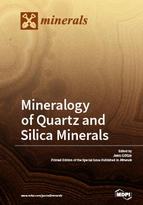Mineralogy of Quartz and Silica Minerals
A special issue of Minerals (ISSN 2075-163X).
Deadline for manuscript submissions: closed (28 February 2018) | Viewed by 97711
Special Issue Editor
Interests: applied mineralogy; quartz and silica; cathodoluminescence
Special Issues, Collections and Topics in MDPI journals
Special Issue Information
Dear Colleagues,
The various modifications of silica, especially quartz, play a central role in the composition of geological materials. In addition, quartz is widely used as raw material in numerous industrial fields. Therefore, the knowledge about specific properties of SiO2 rocks and minerals is indispensable for the understanding and reconstruction of geological processes, as well as for specific technical applications. This Special Issue aims to bring together studies dealing with the formation, mineralogy and geochemistry of quartz and other silica minerals. These topics include the formation of quartz deposits and problems of processing, aspects of the analysis of high-purity quartz, as well as specifics of SiO2 modifications and varieties (e.g., opal, chalcedony, agate, quartz).
Prof. Dr. Jens Götze
Guest Editor
Manuscript Submission Information
Manuscripts should be submitted online at www.mdpi.com by registering and logging in to this website. Once you are registered, click here to go to the submission form. Manuscripts can be submitted until the deadline. All submissions that pass pre-check are peer-reviewed. Accepted papers will be published continuously in the journal (as soon as accepted) and will be listed together on the special issue website. Research articles, review articles as well as short communications are invited. For planned papers, a title and short abstract (about 100 words) can be sent to the Editorial Office for announcement on this website.
Submitted manuscripts should not have been published previously, nor be under consideration for publication elsewhere (except conference proceedings papers). All manuscripts are thoroughly refereed through a single-blind peer-review process. A guide for authors and other relevant information for submission of manuscripts is available on the Instructions for Authors page. Minerals is an international peer-reviewed open access monthly journal published by MDPI.
Please visit the Instructions for Authors page before submitting a manuscript. The Article Processing Charge (APC) for publication in this open access journal is 2400 CHF (Swiss Francs). Submitted papers should be well formatted and use good English. Authors may use MDPI's English editing service prior to publication or during author revisions.
Keywords
- quartz
- opal
- agate
- SiO2 deposits and raw materials
- processing of quartz raw materials
- analytics of high-purity quartz
- quartz mineralogy
- structure and properties of quartz
- geochemistry/trace elements
- spectroscopic methods






